Plum Jam
This post may contain affiliate links. See my disclosure policy.
This plum jam recipe is easy to make and is delicious not only spread on bread and toast but added to cakes, in muffins, on pancakes, ice cream and any other way your heart desires! You can make it either with or without pectin.
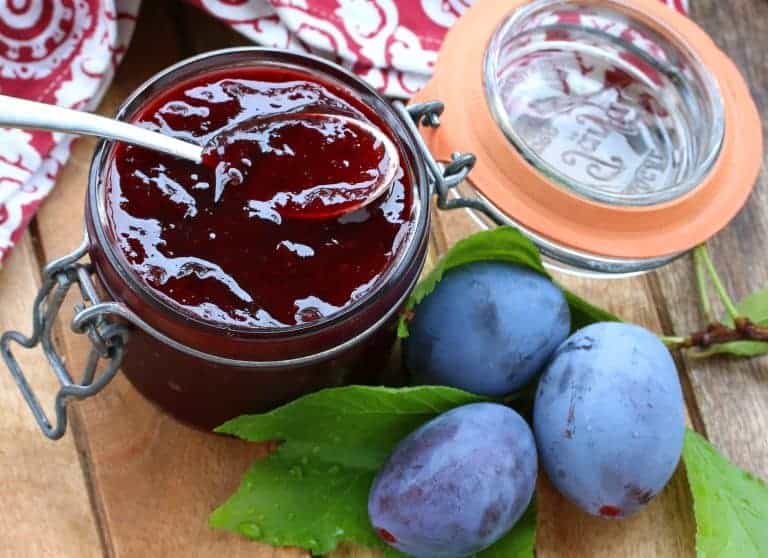
Homemade Plum Jam Without Pectin or With
With four Italian plum trees in our yard I get busy the end of every Summer processing loads of plums every which way possible: Dried, canned, frozen, dehydrated, turned into Fruit Leather, cakes (including this German Plum Cake), cobblers, Plum Butter, Plum Sauce (aka duck sauce) and anything else I’m able to think of.
Plum jam is another great way to turn those wonderfully plump, flavorful and juicy plums into something delicious that you can enjoy all year long. And you have the option whether to use pectin or make it without. Whether you’re spreading it on toast, drizzling it over waffles or ice cream or any other way your heart desires, you’re going to love the fresh and vibrant flavor of this homemade plum jam!
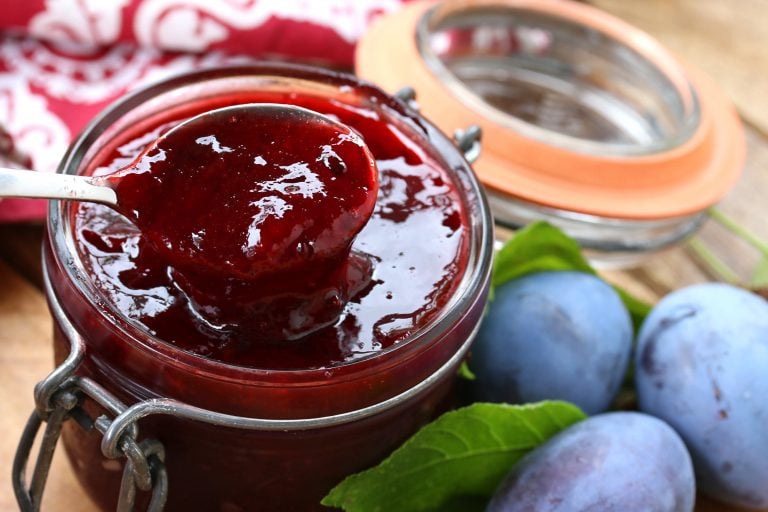
Plum Jam Recipe
Let’s get started!
Wash the plums, cut them in half, discard the pits and place the plums in a large pot.
To chop or not to chop the plums:
- If you’re NOT using pectin and are letting the jam simmer for a long time, there’s no need to chop them because they’ll break down by themselves and you can always give the jam a mash or use a hand blender to puree part of it later on if you don’t want as many chunks.
- If you ARE using pectin that means the jam will only boil for a few minutes and the plums will not break down, so go ahead and chop the plums up.
Add the sugar and lemon juice heat the pot, initially over medium heat so the plums or sugar don’t scorch. Once the plums juices start to run you can increase the heat.
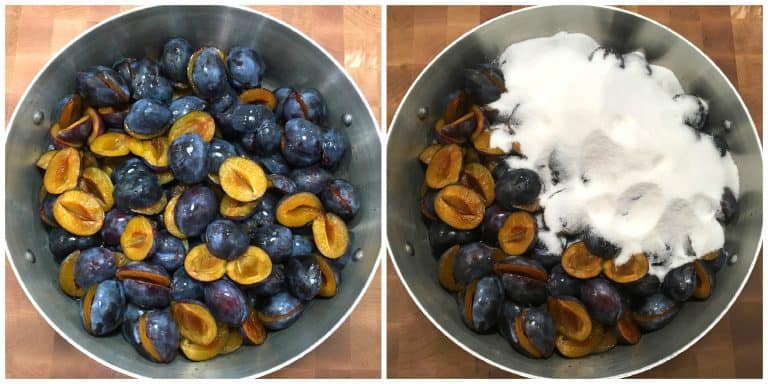
If you’re NOT using pectin: Simmer the plum uncovered until an instant read thermometer reads 220 degrees F. That’s important in order for the jam to set and not be too runny. Alternatively, freeze a couple of spoons and drop some jam onto them: If the jam sets and is spreadable, but not runny, it is done.
Don’t bother skimming off the foam because that will all dissolve by itself towards the end.
If you ARE using pectin: Follow the package instructions of whatever pectin you are using. Skim off the foam.
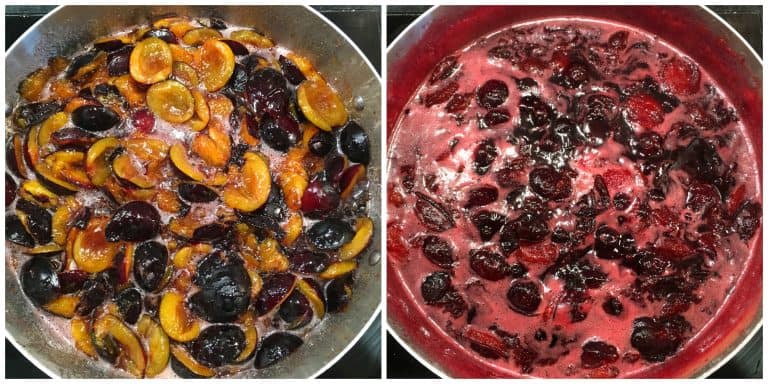
If you like you can use a potato masher or a hand-held immersion blender to mash/blend part of the jam until the desired amount of chunkiness is reached.
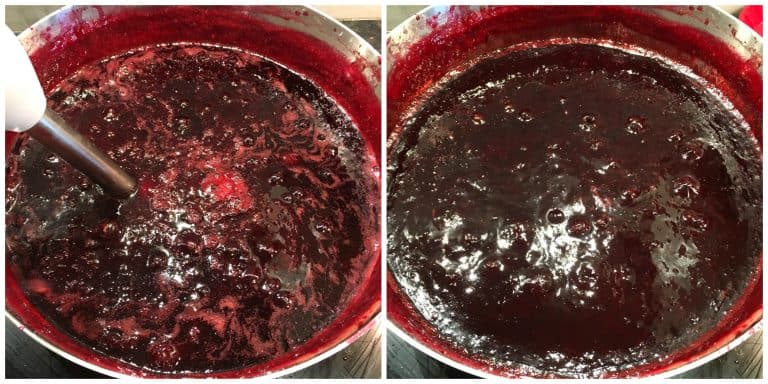
How to Can Plum Jam
Using sterilized jars, ladle the hot jam into the jars and wipe off the rims with a moist towel to make sure no jam is on the rims. Fill each jar leaving 1/4 inch headspace. Wash the lids with soapy water and, place them on the jars and screw on the sterilized rings. Boil them in a water bath canner for 10 minutes.
Carefully remove the jars and let them sit undisturbed for 24 hours before removing the rings (optional) and storing them in a cool place. They will keep for up to a year. Once opened, store in the fridge, will keep for at least a month.
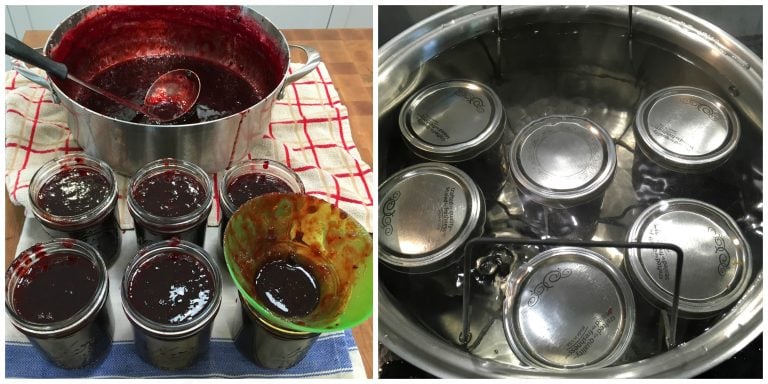
Ways to Enjoy It
There are lots of ways you can enjoy your delicious homemade plum jam. Here are just a few ideas:
- Spread on bread, toast, scones, sourdough English muffins or crumpets.
- Served with waffles or pancakes (see my whole wheat sourdough waffles and oat waffles).
- Used as a filling for jelly rolls, donuts, turnovers, tarts, muffins, and cakes (see my Victoria sponge cake, whole grain jam squares and Berliner).
- Drizzled over ice cream or homemade yogurt.
Enjoy!
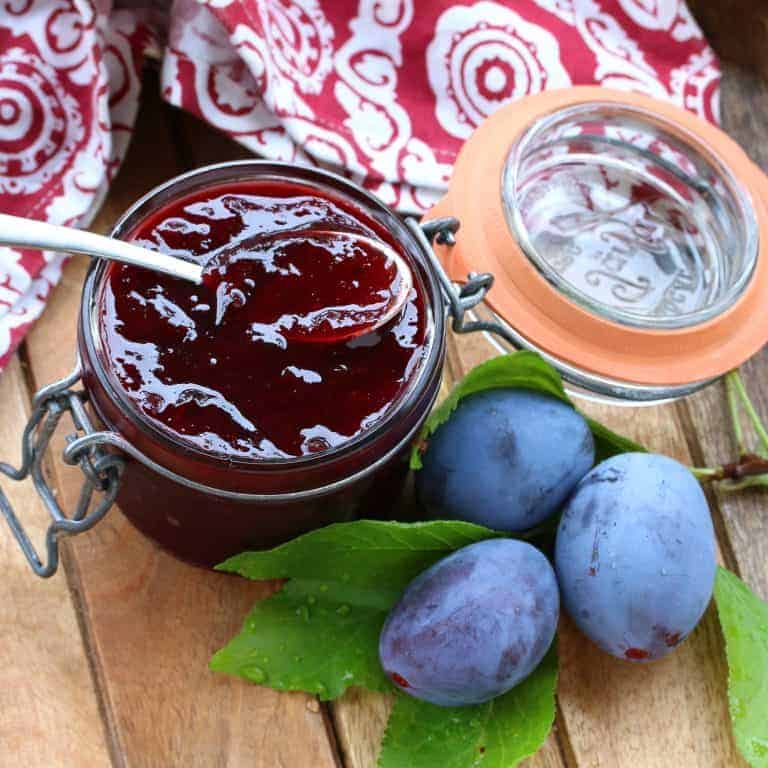
For more delicious homemade jam recipes be sure to try my:
- Gooseberry Jam
- Strawberry Rhubarb Jam
- Blackberry Jam
- Huckleberry Jam
- Black Currant Jam
- Plum Jam
- Red Currant Jelly
- Lemon Lime Marmalade
- Blueberry Lemon Apricot Jam
- Caramel Pear Butter
- Toasted Hazelnut & Date Spread
- Peach Bacon Jam
Save This Recipe
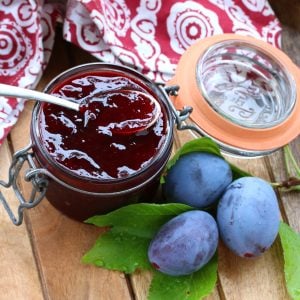
Plum Jam
Ingredients
- 4 pounds Italian plums , washed, cut in half and pits removed
- 4 cups granulated sugar
- 2 tablespoons lemon juice
Instructions
- Wash the plums, cut them in half, discard the pits and place the plums in a large pot.To chop or not to chop the plums:If you're NOT using pectin and are letting the jam simmer for a long time, there's no need to chop them because they'll break down by themselves and you can always give the jam a mash or use a hand blender to puree part of it later on if you don't want as many chunks.If you ARE using pectin the jam will only need boil for a few minutes and the plums will not break down, so go ahead and chop the plums up.Add the sugar and lemon juice and heat the pot, initially over medium heat so the plums or sugar don't scorch. Once the plums juices start to run you can increase the heat.
- If you’re NOT using pectin: Simmer the plum uncovered until an instant read thermometer reads 220 degrees F. That’s important in order for the jam to set and not be too runny. (Alternatively, freeze a couple of spoons and drop some jam onto them: If the jam sets and is spreadable, but not runny, it is done.) Don’t bother skimming off the foam because that will all dissolve by itself towards the end.If you ARE using pectin: Follow the package instructions of whatever pectin you are using. Skim off the foam.If you like you can use a potato masher or a hand-held immersion blender to mash/blend part of the jam until the desired amount of chunkiness is reached.
- Using sterilized jars, ladle the hot jam into the jars and wipe off the rims with a moist towel to make sure no jam is on the rims. Fill each jar leaving 1/4 inch headspace. Wash the lids with soapy water and, place them on the jars and screw on the sterilized rings. Boil them in a water bath canner for 10 minutes.Carefully remove the jars and let them sit undisturbed for 24 hours before removing the rings (optional) and storing them in a cool place. They will keep for up to a year. Once opened, store in the fridge, will keep for at least a month.Makes about 3 1/2 pints or 7 half pints.
Nutrition
Originally published on The Daring Gourmet September 28, 2018



















do you mash them before cooking or after?
After, when they’re very soft. Then you can mash them according to your desired consistency.
This recipe didn’t work for me. I used no pectin but otherwise followed the instructions carefully, used a instant read thermometer to get the temp right, and it unfortunately the jam didn’t gel. Regardless of the temperature instruction, it might be good to have an estimate of how long you need to let it boil to reach the point where it will gel. This recipe also does not mention the plum skins. I included mine, and they all fell off in the boiling process, and then I had to extract them from the hot fruit mixture. I uncanned all my jars, added a full package of powdered Certo, resterilized everything, and am trying again. Why is jam so hard?
Hi KT, for jam to gel you either need 1) pectin or 2) enough sugar and the right temperature. Having enough sugar and allowing the mixture to get up to temperature is critical for getting jam to gel, especially when the fruit being used is naturally low in pectin. The boiling time will vary depending on the temperature of your stove, the kind of pot you’re using, the diameter of the pot, etc, so it’s not helpful to state a set length of time. Instead you simply boil it until it’s up to temp or, alternatively, to perform the wrinkle test to see if the jam has set. If you brought the jam up to the right temperature and it still did not gel then it sounds like either your thermometer isn’t accurate, you reduced the sugar, or you doubled the recipe which often just doesn’t work well for making jam. As for the skins – those are typically just left on. They’re perfectly soft and don’t negatively alter the texture of the jam at all.
Don’t use this recipe with added pectin – it won’t gel because the proportions of fruit to sugar are wrong. I usually make jams with added pectin and was suspicious, but decided to try it anyway. Sure enough, it made much more than the 7 half pints, and the jam didn’t gel. It looks like the proportions would be right for jam that you cook down, which is what I will probably do as I open my jars. Also, I just realized that her photo shows Italian prune plums, and I used the type you are more likely to find in the grocery store (red skin, yellow pulp), which have a much higher juice to pulp ratio. It would be helpful if the recipe specified the type of plum to use.
You said fill the jars no LESS than 1/4 inch from the top. Do you mean no MORE than 1/4 inch from the top? Most of the time canning instructions say to leave at least 1/2 to 1 inch at the top of the jar unfilled! Thanks for clarifying this for me
Hi Glenda, you’ll need to leave 1/4 inch of headspace. No more than that is necessary for jams or jellies.
The recipe says it makes 224 1 Tbsp servings, which comes out to 112 fl. oz. However, the recipe ALSO claims it yields about 7 half-pints, which is just 56 fl. oz. Which is correct?
Hi John, the conversion software sure went a little beserk on the tablespoons :) The roughly 7 half pints is correct.
Just made this, no pectin and came out lovely! So good!
I’m so glad, Sharry, thank you!
I am looking forward to trying this recipe, but I pre-halved and pitted all my plums in summer and froze them. Do you know how many pounds of plums i would need now? Thanks!
Made this today… worked wonders… I actually got 10 1/2 pints yield. House still smells wonderful
Fantastic, Jamie, I’m so glad it was a success!
Do you have to peel the plums?
Hi Tracey, no you don’t, they will break down when cooked.
Do you have to can this recipe or can it be frozen? I don’t have a canner to do a water bath
Hi Megan, you can definitely freeze this. Also just FYI, you can use any large pot to water bath can jars as long as it’s deep enough to cover the jars by at least a couple of inches (you can also use small jars) and by putting a clean dish cloth on the bottom to prevent the jars from making contact with the pot. Then you can crush a little tin foil to put between the jars so they don’t knock against each other while they’re boiling.